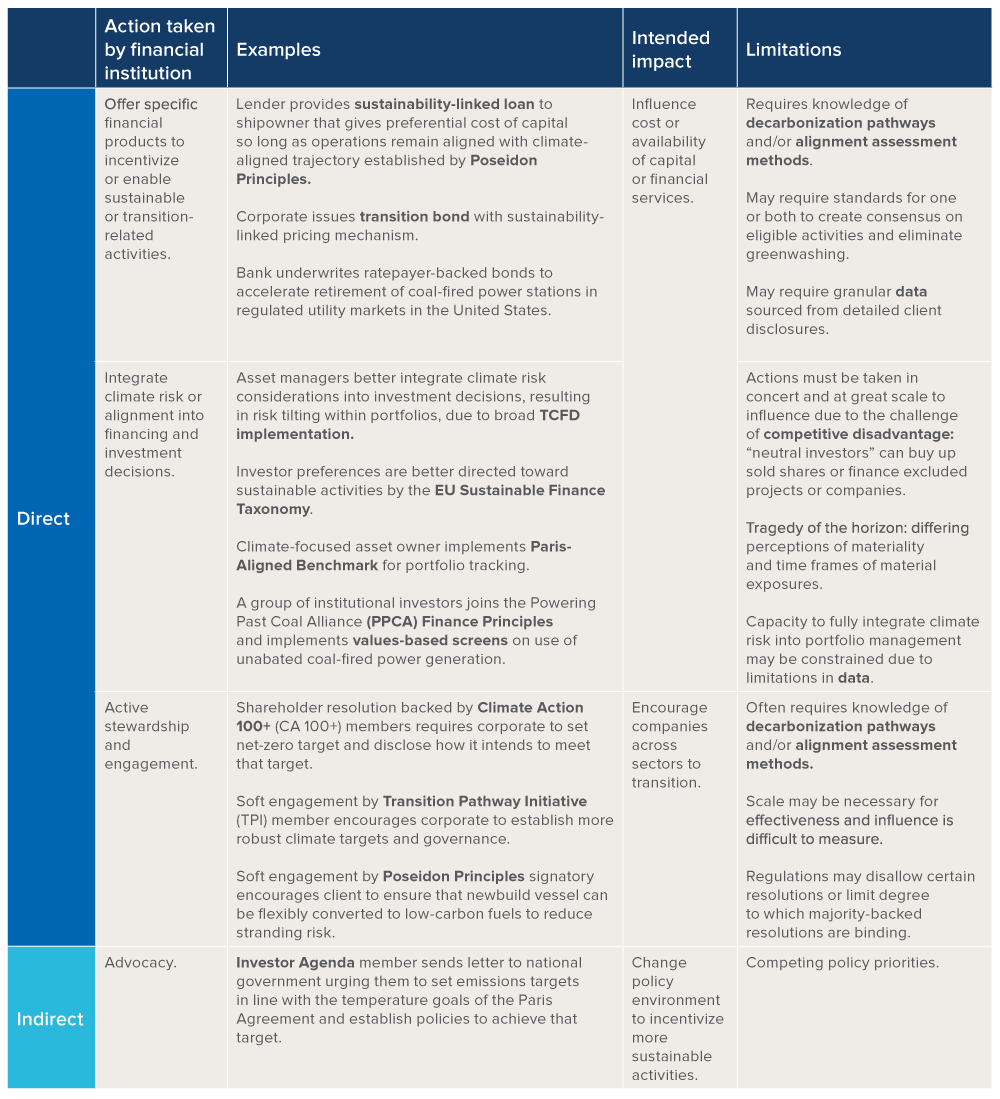Hand moving pawn on a conceptual maze. Shortcut to success or career guidance concept. Composite image between a hand photography and a 3D background.

Translating the Landscape of Climate Action Efforts in the Financial Sector
The debate over whether private financial institutions should play a proactive role in the low-carbon transition is coming to a close and significant efforts to define what this role should be in practice have begun.
The role of private finance in climate action is being defined by two significant trends. First, the global acceptance that climate risks are a threat to financial stability has taken root. A mere three years after the publication of the recommendations of the Task Force on Climate-Related Financial Disclosures (TCFD), regulators in many of the world’s major financial markets are increasing or mandating climate-related disclosures from corporates. Concurrent with this, the largest asset management firms are pushing for reporting standardization and threatening to use voting power against corporates who fail to comply, and financial supervisors are increasing scrutiny of banks and insurers.
Second, asset owners and lenders representing tens of trillions in assets have begun to move beyond such considerations to make good on their commitments to align their portfolios with the Paris Agreement. Policy makers across the globe are establishing taxonomies and strenuous climate benchmarks to better mobilize and redirect capital toward sustainable activities and investor expectations of “impact” are increasing. Nations such as the United Kingdom, France, Germany, and Denmark have even set legally binding net-zero emissions targets for 2050—with the entire European Union poised to adopt that standard.
In its inaugural publication, Breaking the Code: Deciphering Climate Action Efforts in the Financial Sector, Rocky Mountain Institute’s Center for Climate-Aligned Finance takes stock of this fast-shifting landscape. While this ground is difficult to navigate for financial institutions and climate action initiatives alike, doing so is crucial for understanding what is being asked of the financial sector. It can inform how structural barriers (and sometimes legal obligations) limit the financial sector’s ability to influence the real economy and which initiatives are working to overcome these barriers to influence.
These efforts are underpinned by one key assumption: that it is within the capacity of financial institutions to influence the real economy in a world often lacking policies to give clear direction on and incentives for industrial decarbonization. Actions taken by private financial institutions are not a wholesale replacement for policy, but they can be influential in reinforcing it, preparing for it, and collectively moving ahead of it. This reality should inform both the actions of financial institutions and the expectation that they develop ambitious, sophisticated, and transparent approaches to influence, which span all available levers of influence.
Furthermore, the history of finance confirms that those institutions which successfully manage the transition will reap financial dividends in the decade to come.
The Center for Climate Aligned Finance previously identified the five major barriers that any financial institution must overcome when seeking to align their portfolios with the temperature goals of the Paris Agreement. These are: working around the structural challenges to influence the real economy, overcoming competitive disadvantage, selecting methodologies to assess alignment, understanding decarbonization pathways, and sourcing adequate data. This report discusses major tends and initiatives by identifying efforts being made to overcome these barriers.
Making Sense of the Evolving Landscape
Today, tremendous efforts are being made by initiatives—many of which are led by financial institutions themselves—to overcome the most significant barriers to influence and better enable financial institutions to actively influence the real economy. This landscape of efforts, illustrated above, can be extremely difficult to navigate. It is even more challenging when considered alongside regulatory and market forces also actively working to shape the role of the financial sector in supporting decarbonization.
Collective Action—A Maturing Response to the Challenge of Influence: Many financial institutions delay meaningful action on climate change to avoid losing clients and investment opportunities to competitors. Yet initiatives across three broad categories are working to overcome this challenge: broad collective engagement and advocacy platforms, collective commitments to action and sector-specific initiatives.
Assessing Climate Alignment and Setting Targets: Different methodologies, platforms and tools for assessing climate alignment and setting targets have emerged as more financial institutions make ambitious commitments to climate alignment. The ability to transparently track and disclose progress is a cornerstone of any legitimate climate alignment commitment or target-setting process, yet many different methodologies exist today. There is a clear and widely acknowledged need for harmonized methodologies to assess climate alignment and to ensure that it can be done comparably.
Translating Decarbonization Pathways for Use by the Financial Sector: Choosing from multiple, often conflicting, sectoral decarbonization pathways remains a barrier for financial institutions. Yet understanding decarbonization pathways and using that understanding to inform product offerings, investment decisions, and engagement is crucial for financial institutions that wish to play a proactive role in decarbonization. Establishing a shared vision of pathways is also crucial for influencing the real economy through collective financial sector action.
Data—Can Reporting Standards Help Fulfill Data Needs? The ability to source adequate, quality data remains a significant barrier to climate alignment. Yet the need for more and better-standardized disclosures is recognized by regulators and financial institutions alike and there are signs of a private-sector led reporting standard emerging.
Decarbonizing the Real Economy – The New Role of Finance?
What is being asked of the financial sector today? Financial institutions across the investment chain are being asked to be proactive in support of decarbonization rather than reactive to policy.
What does it look like in practice? A climate alignment commitment is a commitment to assess alignment with climate targets and improve that alignment through product offerings, investment and financing decisions, and engagement. It is a commitment to influence the real economy. There are limitations to the influence of financial institutions, but this does not absolve them of the responsibility to proactively support decarbonization. Instead, financial institutions should be expected to develop ambitious, sophisticated, and transparent approaches to influencing the real economy that span all levers of influence.
To read more download: Breaking the Code: Deciphering Climate Action Efforts in the Financial Sector (hyperlink here)
